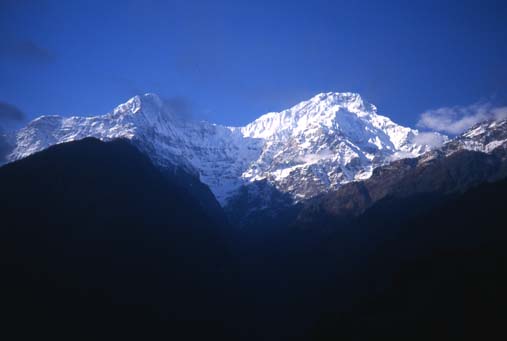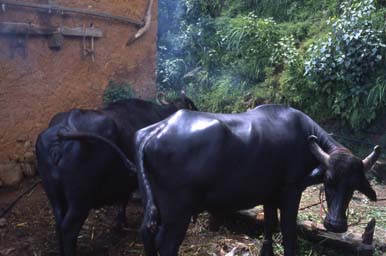
 |
CHIPKO: A case study in CIVIL DISOBEDIENCE Ryan Redmond |
|
ACTIVITY FIVE: Community Forestry in Nepal
Map of Nepal. Source. "Hill farmers are highly dependent on forest products," writes Naomi Bishop in Himalayan Herders, her fascinating study of the village of Melemchi in the Yolmo Valley north of Kathmandu (68). Foliage from forests provide domesticated animals with food, animals which provide milk, labor and in some cases meat and other usable body materials. Forests obviously also provide fuel - in the form of wood - for cooking and heating. While manufactured fertilizer for agricultural fields is more and more common in the Himalaya, human and animal dung as well as detritus off the forest floor are all used to nourish fields. Forests act as potential agricultural fields, just as they act to maintain mountain slopes, as the young Himalayas and their foothills are especially vulnerable to erosion. Bishop reminds us again that "All in all, agropastoral subsistence in the Himalaya is predicated on access to forest" (68). Nepal, which shares a significant stretch of border with Uttar Pradesh, where the Chipko movement began, has one of the most developed community forestry programs in the world. Nepal's community forestry program has largely been focused in the middle hills but has spread to other areas as well, namely the terai. Nepal, one of the poorest countries in the world according to many indicators, has one of the most developed systems for administering and systemitizing the use of forests. How has this come about? Just what does the system look like? Better yet, more accurately, what do the systems look like? At what level do these systems exist? At the national level? District level? Village level? Within these strata, who makes the decisions?
Looking out a window of a house in the middle hills of Nepal, a few days walk south of Kathmandu. In a country where vast numbers of people rely directly on the land for survival and on forest resources in particular, the health of forests is just as important as the health of agricultural land.
Water buffalo in the middle hills of Nepal provide many things to the people who keep them. The animals too rely on products from the forest, namely fodder. At this moment in time, this portion of the website is really more and introduction and a collection of resources than it is an activity. That said, these resources could very easily be put to use for the purposes of some sort of activity, even one which follows directly from a study of Chipko. In a sense, a look at forestry in Nepal could be viewed - to return to the themes outlined on the very first page, Conflict Resolution, Civil Disobedience and Nonviolence and Law and Order - through these lenses. Conflict over land use begets systems of management. Systems of management are, by definition, elements of law and order. Community Forest Management in the Middle Hills of Nepal: The Changing Context. Oliver Springate-Baginski, et all. (Journal of Forest and Livelihood 3(1) July, 2003.) Need to strengthen forest conservation stressed. (June 2, 2003, The Kathmandu Post.) Federation of Community Forestry Users, Nepal The Search for Clarity in Nepal's Forestry Policy. (September 29 - October 19, 2000, Spotlight.) Community Forestry in Nepal (1978-2010): Forest Policy. Amrit Lal Joshi, Ministry of Forests and Soil Conservation, Nepal, 1997. Community Forestry in India and Nepal, Trupti Parekh Mehta, PERC
|
This site was created by Ryan Redmond at the NEH Summer Institute "Cultures and Religions of the Himalayan Region," held at the College of the Holy Cross, Summer 2006


